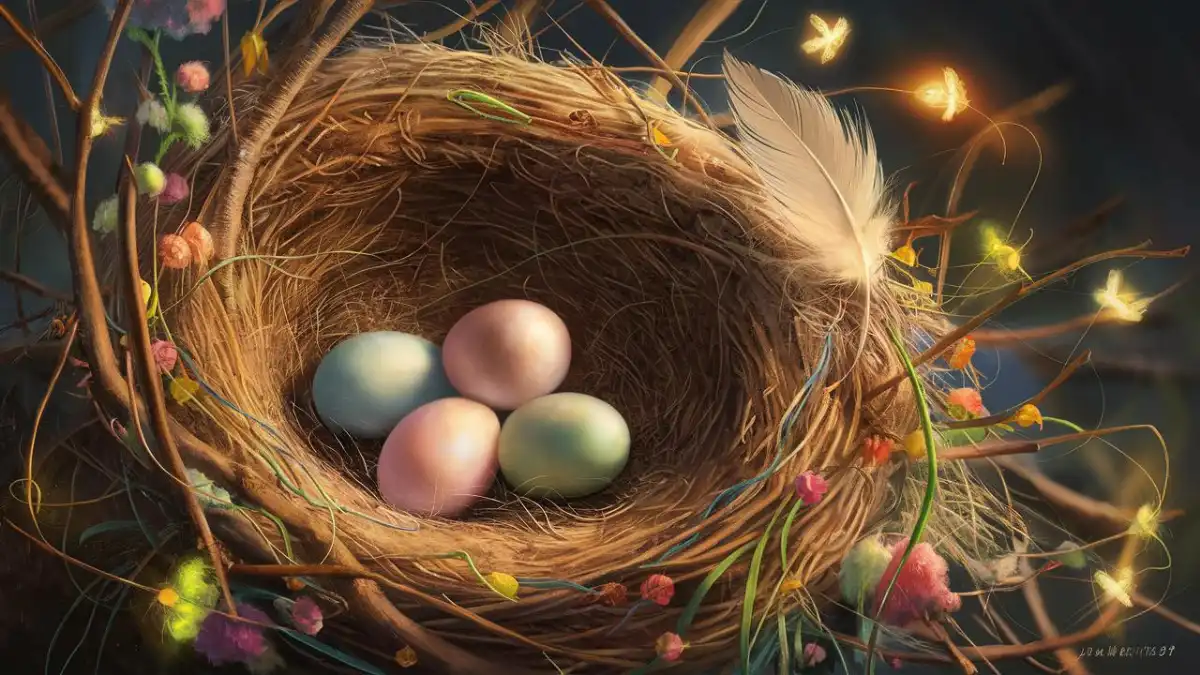The Surprising Symbolism of Birds and Their Nests

Have you ever watched a bird build its nest? It’s truly fascinating! These tiny homes represent far more than just a place for eggs. Birds and their nests are powerful symbols in cultures worldwide, embodying freedom, new beginnings, and nurturing care.
As creatures of the air, birds often symbolize spiritual connections and transcendence. Their nests, crafted with remarkable skill, showcase nature’s ingenuity and wisdom. From the majestic eagle to the humble sparrow, each species carries its own symbolic weight in folklore and art.
In this article, we’ll explore the rich meanings behind birds and their nests across various traditions. You might never look at that little nest in your backyard the same way again!
Key Takeaways
The Meanings of Birds
Birds have long been seen as messengers between heaven and earth. Their ability to soar high in the sky has led many cultures to view them as spiritual beings. Here’s a quick look at what some common birds symbolize:
- Eagles: These majestic birds often represent power, freedom, and spiritual growth. In many Native American traditions, eagles are considered sacred messengers to the divine.
- Cranes: Known for their graceful dances, cranes symbolize longevity, good fortune, and fidelity in many Asian cultures. Their nest symbolism is particularly strong, representing harmony in the home.
- Falcons: These swift hunters are associated with nobility, focus, and achievement. In ancient Egypt, the falcon-headed god Horus was a symbol of divine kingship.
- Owls: Often linked to wisdom and intuition, owls also have a darker side in some folklore. Their nocturnal nature has led to associations with the supernatural and hidden knowledge.
- Hummingbirds: These tiny powerhouses symbolize joy, resilience, and adaptability. In many indigenous American cultures, hummingbirds are seen as healers and bringers of good luck.
- Nightingales: Famed for their beautiful songs, nightingales often represent love, creativity, and the power of voice in folklore and literature.
- Peacocks: With their stunning plumage, peacocks symbolize beauty, pride, and spiritual awakening in various traditions. The “eyes” on their feathers are sometimes seen as symbols of all-seeing wisdom.
- Sparrows: These common birds represent simplicity, hard work, and community. In many cultures, sparrows are seen as friendly messengers between the human and spirit worlds.
- Canaries: Often kept as pets for their cheerful songs, canaries symbolize happiness, domestic harmony, and sensitivity to one’s environment.
- Swans: These elegant water birds are associated with grace, purity, and true love in many European traditions. Their nest symbolism often relates to family bonds and devotion.
Eagles: Symbols of Power and Freedom
When we think of majestic birds, eagles often come to mind first. These powerful raptors have captivated human imagination for millennia. In many cultures, eagles are seen as divine messengers, bridging the gap between earth and sky.
- For Native American tribes, eagles hold special significance. The Zuni people, for example, see the eagle as a symbol of spiritual strength and connection to the Creator. Eagle feathers are often used in important ceremonies and rituals, representing honor and respect.
- In ancient Rome, the eagle was associated with Jupiter, king of the gods. Roman legions carried eagle standards into battle, believing these symbols would bring victory. This tradition influenced many modern nations, including the United States, which adopted the bald eagle as its national emblem in 1782.
The eagle’s keen eyesight has led to associations with foresight and strategic thinking. In business and leadership contexts, “eagle-eyed” is a common phrase for someone who notices important details. The eagle’s ability to soar at great heights also symbolizes the ability to rise above everyday concerns and see the bigger picture.
Nest Symbolism Eagles
Takes on special meaning with eagles. Their massive nests, sometimes weighing over a ton, represent stability and long-term commitment. Eagles often return to the same nest year after year, adding to it each season. This behavior has inspired human ideas about building strong foundations for family and community.
Cranes: Harbingers of Good Fortune
Cranes hold a special place in the folklore of many Asian cultures. In Japan, the red-crowned crane is a symbol of longevity and good fortune. The famous tradition of folding 1,000 paper cranes (senbazuru) is believed to grant the folder a wish or lasting good luck.
The graceful mating dances of cranes have inspired human art and culture for centuries. In many traditions, crane dances are performed at weddings, symbolizing harmony and fidelity between partners. The sight of two cranes building a nest together is often seen as a good omen for new couples.
- Chinese folklore associates cranes with wisdom and longevity. In Taoist tradition, cranes are sometimes depicted carrying immortals on their backs. The image of a crane standing on a tortoise is a common symbol for a long and prosperous life.
Nest Symbolism Cranes
Is particularly strong with cranes. Their large, carefully constructed nests represent domestic harmony and the creation of a safe, nurturing home. In some cultures, finding a crane’s nest is considered extremely lucky, promising abundance and protection for one’s family.
Falcons: Swift Symbols of Victory
Falcons have long been associated with nobility and martial prowess. Their incredible speed and hunting skills have made them popular in falconry, a practice that dates back thousands of years. In many cultures, the ability to train and hunt with falcons was a mark of high social status.
- In ancient Egypt, the falcon-headed god Horus was one of the most important deities. Horus represented divine kingship and the power of the pharaohs. The “Eye of Horus” symbol, based on a falcon’s eye, was believed to offer protection and good health.
- Medieval European heraldry often featured falcons, symbolizing the nobility’s love of hunting and their swift, decisive nature. The peregrine falcon, capable of diving at speeds over 200 mph, became a symbol of focused determination and achieving one’s goals.
Nest Symbolism Falcons
While falcons don’t build elaborate nests like some birds, their nest symbolism is still significant. Falcon nests, often located on high cliffs or tall buildings, represent lofty ambitions and the ability to reach great heights. The care falcons show for their young in these precarious nests symbolizes protection and nurturing even in challenging circumstances.
Owls: Wisdom in the Darkness
Owls have a complex symbolism that varies widely across cultures. In many Western traditions, owls are associated with wisdom and knowledge. This connection likely stems from their large eyes and seemingly contemplative expression. The ancient Greek goddess Athena, known for her wisdom, was often depicted with an owl.
However, owls’ nocturnal nature has also led to darker associations in some cultures. In many parts of Africa and the Middle East, owls are seen as harbingers of death or bad luck. Their haunting calls at night have fueled superstitions and ghost stories for generations.
Native American traditions often view owls as powerful spirit animals. For some tribes, owls are associated with sacred knowledge and the ability to see hidden truths. However, other tribes see owls as warnings of danger or death.
Nest Symbolism for Owls
Often relates to hidden knowledge and secrets. Owl nests, typically located in hollow trees or abandoned buildings, represent the importance of finding quiet, secluded spaces for reflection and learning. The way owls fiercely protect their nests and young has also inspired ideas about guarding one’s wisdom and sharing it only with those who are ready.
Hummingbirds: Joy in Motion
These tiny, colorful birds have captured human imagination with their incredible flying abilities and beauty. In many Native American traditions, hummingbirds are seen as healers and bringers of love. Their ability to hover and fly backwards is often interpreted as a symbol of being able to reflect on the past while moving forward.
Aztec mythology associated hummingbirds with their god of war, Huitzilopochtli. The belief was that fallen warriors would be reincarnated as hummingbirds. This connection between such a small, delicate creature and the concept of warrior strength is a powerful reminder that size isn’t everything.
In modern times, hummingbirds often symbolize joy, resilience, and adaptability. Their high metabolism and constant motion represent living life to the fullest and finding sweetness in each moment. Many people see encounters with hummingbirds as reminders to enjoy the simple pleasures in life.
Nest Symbolism for Hummingbirds
Their tiny, cup-shaped nests are marvels of engineering, built with spider silk for elasticity. These nests represent the ability to create a safe, comfortable home even with limited resources. The care hummingbirds show in building and maintaining their nests symbolizes attention to detail and the importance of creating a nurturing environment.
Nightingales: Songs in the Dark
The nightingale, famed for its beautiful nocturnal song, has inspired poets and storytellers for centuries. In many cultures, the nightingale symbolizes love, creativity, and the power of voice. The bird’s ability to sing in the darkness has made it a powerful metaphor for finding beauty and hope in difficult times.
In Persian poetry, the nightingale is often paired with the rose, representing the lover and the beloved. This romantic symbolism has spread to many other cultures, with the nightingale’s song seen as a declaration of love and longing.
Hans Christian Andersen’s fairy tale “The Nightingale” uses the bird as a symbol of natural, authentic beauty contrasted with artificial imitations. This story highlights the nightingale’s association with truth and genuine emotion.
Nest symbolism for Nightingales
Often relates to the creation of art and the nurturing of talent. Just as nightingales build their nests in dense bushes, hidden from view, artists and creators often need secluded spaces to develop their skills. The nightingale’s nest represents a safe place for vulnerability and self-expression.
Peacocks: Beauty and Pride
With their stunning plumage, peacocks have long been symbols of beauty, pride, and spiritual awakening. In many cultures, the peacock’s tail feathers, with their eye-like patterns, represent all-seeing wisdom or protection against evil.
In Hinduism, the peacock is associated with several deities, including Kartikeya, the god of war, and Saraswati, the goddess of knowledge and arts. The bird’s beauty is seen as a manifestation of divine grace and spiritual transformation.
Christianity adopted the peacock as a symbol of immortality and resurrection. This association came from the ancient belief that peacock flesh didn’t decay. In medieval Europe, peacock feathers were often used in religious art and architecture.
While peacocks are known for their beauty, their loud, harsh calls provide an interesting contrast. This has led to peacocks sometimes symbolizing the idea that external beauty doesn’t always match inner qualities.
Nest symbolism for Peacocks
Is less prominent, as male peacocks don’t participate much in nest-building or chick-rearing. However, the idea of “displaying one’s feathers” to attract a mate has become a metaphor for showing off one’s best qualities or achievements.
Sparrows: Simplicity and Community
These small, common birds might seem unremarkable at first glance, but they hold rich symbolic meaning in many cultures. Sparrows often represent simplicity, hard work, and the strength found in community.
- In ancient Egypt, sparrows were associated with poor or common people, but this wasn’t a negative connotation. Instead, it represented the idea that even the smallest or most ordinary beings had value in the eyes of the gods.
- Christian tradition has used sparrows as symbols of God’s care for all creatures. The Gospel of Matthew mentions that not even a sparrow falls without God’s knowledge, emphasizing divine attention to even the smallest details of creation.
- In many Asian cultures, sparrows are seen as lucky birds, bringing good fortune to households. Their cheerful songs and social nature have made them symbols of happiness and community spirit.
Nest symbolism for Sparrow
Nest symbolism is particularly strong with sparrows. Their ability to build nests in a variety of locations, often close to human habitation, represents adaptability and finding home wherever one goes. Sparrow nests, while not elaborate, are sturdy and functional, symbolizing the importance of creating a safe, comfortable space without excess.
Canaries: Voices of Warning and Joy
Canaries are perhaps best known for their historical use in coal mines, where they served as early warning systems for dangerous gases. This has led to the phrase “canary in the coal mine,” meaning an early indicator of potential danger.
Beyond this serious role, canaries are beloved for their cheerful songs and bright yellow plumage. In many cultures, canaries symbolize happiness, light, and the arrival of spring. Their melodious voices have made them popular pets for centuries, bringing a touch of nature’s beauty into homes.
In some traditions, canaries are associated with the sun and its life-giving energy. Their yellow feathers are seen as a representation of vitality and positive energy. Dreaming of a canary is often interpreted as a sign of upcoming joy or good news.
Nest symbolism for Canaries
Nest symbolism for canaries often relates to creating a harmonious home environment. Canaries are meticulous nest-builders, carefully weaving together soft materials. This behavior has inspired ideas about the importance of creating a comfortable, nurturing space for oneself and loved ones.
Swans: Grace and Transformation
Swans, with their elegant white plumage and graceful movements, have inspired myths and legends across many cultures. In Western traditions, swans often symbolize purity, love, and transformation.
The famous fairy tale “The Ugly Duckling” by Hans Christian Andersen uses the swan as a symbol of hidden beauty and the process of personal growth. This story has made swans powerful symbols of transformation and the idea that true beauty comes from within.
- In many European traditions, swans are associated with love and fidelity. Swans often mate for life, and the image of two swans with their necks forming a heart shape has become a popular symbol of romantic love.
- Celtic mythology features swans in several important stories, often as symbols of the soul or as shape-shifting beings. In some Irish legends, children of a god were turned into swans, linking these birds with divine transformation.
Nest Symbolism for Swan
Nest symbolism is particularly strong with swans. Their large, carefully constructed nests represent the creation of a safe, nurturing home environment. Swan nests are often built on small islands or near shorelines, symbolizing the balance between security and adventure, home and exploration.
The Spiritual Significance of Nests
Throughout our exploration of bird symbolism, we’ve touched on the importance of nests. Now, let’s dive deeper into the spiritual significance of these remarkable structures. Nests represent more than just a place for birds to lay eggs. They symbolize:
1. Home and Security: The carefully constructed nest represents the creation of a safe haven. In many spiritual traditions, this symbolizes the importance of creating a secure emotional and spiritual foundation.
2. New Beginnings: Nests are where new life begins. This makes them powerful symbols of rebirth, fresh starts, and the potential for growth.
3. Nurturing and Care: The way birds tend to their nests and young represents the importance of caregiving and creating a supportive environment for growth.
4. Creativity and Resourcefulness: Birds build nests using whatever materials are available, often creating beautiful structures from simple elements. This symbolizes human creativity and the ability to make something meaningful from the resources at hand.
5. Cycles of Life: Nests are typically used for one breeding season and then abandoned, representing the natural cycles of creation, use, and release.
Nest symbolism appears in many spiritual and religious contexts.
- In Christianity, for example, the phrase “nest of the dove” is sometimes used to represent the church as a place of spiritual nurturing.
- In some Native American traditions, finding an abandoned nest is seen as a sign of upcoming positive changes or a reminder to create one’s own safe space.
Final Words
As we’ve seen, birds and their nests hold a wealth of symbolic meaning across cultures and spiritual traditions. From the majestic eagle to the tiny hummingbird, each species carries its own significance, teaching us about power, love, wisdom, and joy.
Nests, in particular, remind us of the importance of creating safe spaces for growth and nurturing. They show us that with creativity and perseverance, we can build beautiful things from simple materials.

About Author
I’m Martin Dakota, a passionate astrologer and dream interpreter with over 20 years of cosmic exploration under my belt. My journey began when a vivid dream accurately predicted a major life event, sparking my fascination with the hidden language of the universe. Know more..






